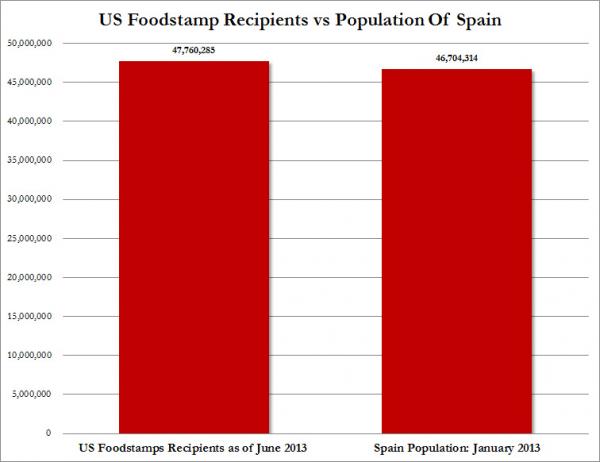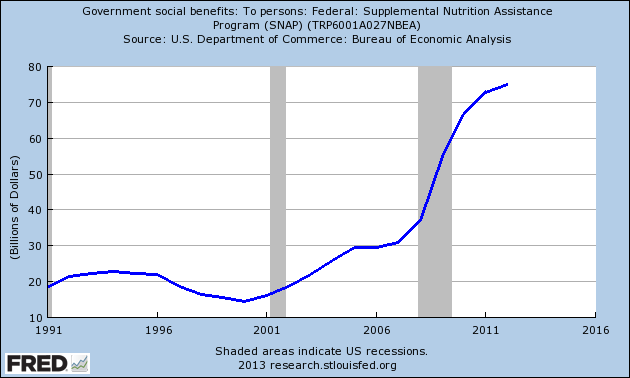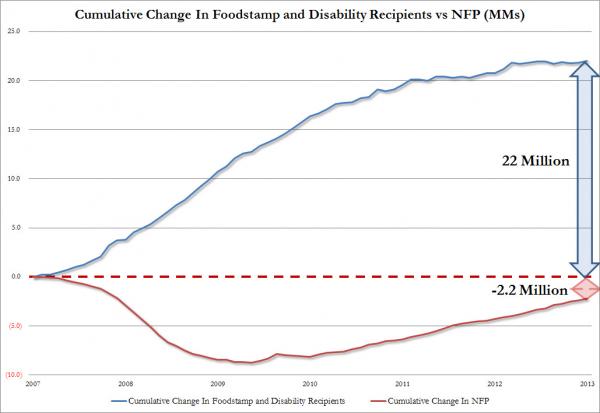United States sets another food stamp record: Households on food stamps at new peak and more Americans live in poverty compared to the entire population of Spain.
- 0 Comments
The gap between rich and poor in the United States continues to grow in-line with food stamp usage. Many Americans watch in dismay as they view countries like Spain rip its self apart by a massively discontent and unemployed youth movement. Many probably watch thinking that somehow, our problems can never come close to what is being experienced abroad. The irony is that we now have more Americans on food stamps than the entire population of Spain. That is right, more Americans are living food stamp payment to food stamp payment versus the entire population of a county literally suffering in depression. Yet somehow, the narrative playing out in the economy is all around a booming real estate market (profits to investors) and the peaking stock market (most Americans don’t even own stock) are big windfalls for all. Yet the gains are being captured by a small portion of the population. This is how we can reach these seemingly dichotomous situations where poverty rises in the shadow of a booming stock market.
Record number of American families on food stamps
I’m not sure this is something that we should be proud about but we now have more Americans on food stamps than the entire population of Spain:
The amount being funneled out in food stamp payments is also at a record level:
When I look at data like this, you fully realize how disjointed this economic “recovery†has become. Recovery for who? Where are we seeing any of the major job growth occurring? The recent BLS reports highlight a troubling trend where the bulk of jobs being added stem from low wage industries. So then it makes sense where you have people landing a part-time gig at Wal-Mart but still qualifying for food stamps. We have a massive amount of what are now working poor Americans. It doesn’t seem like this trend is reversing given that the recession ended in 2009 and we are peaking in terms of food stamp usage all the way in 2013.
Food stamps are operated under the SNAP umbrella, Supplemental Nutrition Assistance Program. The amount given out each month is relatively small, something like $275 on average per family. The income thresholds are strict and you have to have virtually no assets to your name to qualify. Given that one-third of Americans have absolutely no savings, this low bar is being met by millions of families. The program was never designed as a permanent landing place for families but it does appear more people are having a tough time moving away from the program. While we are still over 2 million jobs below where we started in the recession of 2007, we are up a whopping 22 million people that now receive food stamps and disability payments since the recession hit.
People can try to polarize the data but the facts are abundantly clear and that is America is creating a large structurally poor segment of the population. The middle class has been severely hit and you have a recipe for a large growing poor population.
It doesn’t help that those 25 to 34 saddled with mountains of student debt have saved about zero dollars for retirement as measured by the median for this group. There is really no glory behind this number. Over 47 million Americans now depend on food stamps for food. Because of the low amount, many tend to gravitate to unhealthy food choices which tend to be more filling in the moment but longer-term are very likely to cause health disease. Last time I went to the dollar store, they had something like two aisles of cereals and candies and one smaller section of vegetables and fruits (although a few years ago there wasn’t even a vegetable and fruit section so this is good). Then we hear about the epidemic of obesity and healthcare costs soaring. Think of illnesses like heart disease or diabetes and some forms of cancer that really do depend on eating habits. The data also backs this up.
You can see that we trade one problem for another here and those thinking this is somehow a solid recovery are choosing to ignore the bigger crisis hitting the nation.
If you enjoyed this post click here to subscribe to a complete feed and stay up to date with today’s challenging market!



 If you enjoyed this post click here to subscribe to a complete feed and stay up to date with today’s challenging market!
If you enjoyed this post click here to subscribe to a complete feed and stay up to date with today’s challenging market!